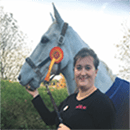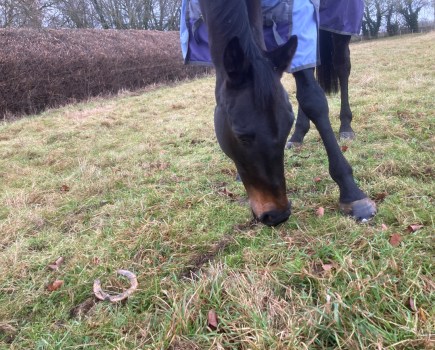There are many benefits in keeping your horse barefoot — the main one being that your horse’s hoof is able to function as nature intended. A barefoot hoof is able to absorb concussion, correctly utilise the frog and soft tissues of the hoof, and spread weight-bearing load over the wall, edge of the sole, heel and frog. A horse’s hoof is also a great reflection of their overall health. Issues such as inflammatory responses and chronic metabolic diseases can be picked up in the feet before any other signs are present.
The benefits of keeping horses barefoot have long been known yet commonly overlooked when it comes to hoof care. However, a horse that slips less when hacking on a wet road or never comes in from the field minus a shoe (because there aren’t any to lose) is a major selling point — and optional barefoot horse boots can help to make the transition easier.
Latest research
A 2022 study by Prof Lars Roepstorff and his team from the Swedish University of Agricultural Sciences found that when barefoot the movement of a horse’s hoof widens over the heel, and there is contraction at the heel during the breakover. (Breakover is when the very last part of the hoof, the toe, leaves the ground.) There was also more vertical independent movement in a barefoot hoof, which could contribute to increased blood flow to the leg — important when recovering from an injury.
Prof Lars Roepstorff, working with Swedish showjumper Peder Fredricson and vet Staffan Lidbeck, set out to gain knowledge about when and how it is appropriate to ride horses with shoes or barefoot. Peder has trained and competed at the highest level, including the Tokyo Olympics, with horses who are unshod and has had positive experiences.
In fact, barefoot horses carried Swedish riders to team and individual gold in showjumping at the 2022 FEI World Championships in Denmark. “I’ve found that [by keeping them] barefoot, the horses are healthier and have fewer injuries, so I think it will be very interesting to show why this is,” said Peder.
Could your horse be barefoot?
So far only preliminary results of the Swedish study have been shared. This first analysis phase was conducted with funding from equine insurer Agria and more results will be announced when they have been analysed. With these early findings being so positive, many owners will be considering whether their own horse could go barefoot — but is barefoot right for every horse?
“There are many advantages to going barefoot,” says Liz Angus, a member of Barefootworks, the UK’s first barefoot trimming practice. “These range from improving the health, shape and quality of your horse’s feet, to less obvious benefits, such as endurance riders noting improved heart rates and recovery times in their barefoot horses, as well as fewer leg injuries caused by concussion.
“Many owners whose horses have struggled with poor hoof health for years often see their horse’s feet change beyond belief when they venture down the barefoot route,” continues Liz. “As an owner, you’ll probably also find you get much more involved in your horse’s hoof care routine when they are barefoot, noticing things about their hooves that you’ve never considered before, so it can be a great learning curve.
Advantages of horses wearing shoes
The pros of horses being shod include:
- Shoes can counteract the effects of poor conformation and help to keep some horses sound.
- Remedial farriery can assist in managing injuries and conditions such as laminitis and navicular.
- Shoes prevent the horse’s hoof wearing down too quickly when working regularly on hard surfaces.
- Being shod helps to protect the horse’s soles from bruising.
- Shoes enable horses to wear studs for extra grip on wet and slippery ground.
- Horses wearing shoes generally have better grip when ridden on grass (even without studs) compared to one that is barefoot.
Advantages of a barefoot horse
The pros of keeping a horse barefoot include:
- It is more natural for the hoof, which is able to function as nature intended.
- Barefoot allows the hoof to work in a way nature intended.
- The hoof isn’t damaged by nails from shoeing.
- A kick from an unshod horse is less damaging than one from a shod horse.
- It could save money as trimming is generally cheaper than shoeing.
- No more lost shoes!
Transitioning a horse to barefoot
When deciding whether your horse should go barefoot, you need to consider whether you have the time to invest in the first few weeks or months of transitioning, and the time it takes varies depending on the individual horse. Some horses may need barefoot horse boots to provide extra protection during exercise initially.
“All horses are capable of being barefoot because, after all, they were born that way. Sometimes, though, their lifestyle is the deciding factor; not all owners are able to keep a barefoot horse and shoes are sometimes necessary to help that horse perform the tasks they’re asked to do,” states Emma Burston, an equine podiatrist specialising in barefoot hoof care.
To prepare your horse for the transition from wearing shoes to being barefoot, undertake some research and find someone you really trust to see you and your horse through the process. Consider the cost too; it may mean more frequent farrier visits at first and investing in a decent pair of barefoot horse boots. A podiatrist can measure your horse and suggest suitable boots if they are needed.
Can you afford it?
Consider whether you have the time and interest to invest in the first few weeks (or months) of transitioning to barefoot.
“The process varies and some horses have their shoes taken off and carry on as before with very little input from trimmer or owner. Some, however — usually those that are compromised either metabolically or in some other way — require a bit more support,” explains Emma. “Some horses may need hoof boots to provide extra protection during exercise initially, so factor in the cost of these too.”
An equine podiatrist will provide you with an individual plan for transitioning your horse at your first appointment. This will cover how to introduce different surfaces gradually.
“It’s important that you follow their advice to give your horse the best chance of making a successful transition,” says Emma. “Introducing different surfaces gradually will condition your horse’s feet to new surfaces gently and avoid any foot soreness or bruising, which doesn’t have to happen when transitioning to barefoot.”
The following needs to be taken into account when deciding to transition to barefoot:
- What you want to do with your horse
- How much time you spend riding on abrasive surfaces, such as stoney bridleway paths and tarmac roads
- Ways to manage barefoot hooves on a daily basis, including hoof picking and regular farriery checks, to ensure hooves stay in good condition.
How is barefoot hoof care different?
According to Emma, caring for a barefoot horse shouldn’t be much different to caring for a shod horse. “A healthy horse creates a healthy hoof, so your equine podiatrist will ensure that your horse’s care doesn’t end at the coronary band,” she says.
“One of the things podiatrists look at prior to a transition to barefoot is that the horse is eating a suitable diet for optimal gut health and therefore optimal hoof health. This should be high in fibre and low in sugar and starch, with access to good quality forage,” continues Emma. “If your horse is sensitive to grass sugars it may be suggested that their access to grass is restricted at certain times of the year, such as in spring, but this isn’t something that necessarily applies across the board. The majority of barefoot horses can be turned out and managed as normal.”
Most barefoot horses are trimmed every six to eight weeks, but this timescale varies from horse to horse.
“Those who do a lot of work on more abrasive surfaces, such as sand or tarmac, may not need trimming quite so regularly,” reasons Emma. “Most barefoot horses can continue to work as usual, whether that be schooling, hacking, roadwork, jumping or whatever you enjoy doing.
Key factors in a happy barefoot horse
A hoof trim from a farrier or podiatrist is around 10% of the successful equation when keeping a horse barefoot; correct diet and exercise makes up the other 90%.
“As the owner, you have to be prepared to take these factors into consideration, often making adjustments to things like your horse’s grazing and sugar intake,” says Liz. “A low sugar balanced diet and lots of exercise are key to stronger, healthier feet. The more you work your horse the more you will stimulate growth and help develop a robust, well-connected hoof capsule with a thick sole.”
Nevertheless, while some horses will breeze through the transition from shod to barefoot, others who may have been shod for long periods, or whose feet have become more compromised, may need more support.
“It’s often necessary to invest in a set of barefoot horse boots,” adds Liz. “These can provide excellent protection while allowing your horse to grow a healthier, stronger foot. The quality and design of barefoot horse boots has improved dramatically in recent years and there are many cutting edge designs on the market to choose from.”
Barefoot horse hoof boots
Lauren Hetherington, a qualified barefoot horse trimmer who runs Graveney Equine in Kent, describes hoof boots as being the bridge between shod and barefoot.
“There are so many shapes, sizes and uses that there is almost always something to suit everyone. Some can be used for turnout or poulticing while others are great for fast work or muddy surfaces,” says Lauren. “I like to use hoof boots on horses who may still be a little tender — either just on more challenging surfaces, or all the time if that’s what they need at first. Ideally you want to be able to transition your horse out of boots as then you’re finally barefoot. However, people will often still use hoof boots if they know there will be lots of stones where they’re going, in order to lower the risk of bruising.”
Barefoot horse boots can be used with pads to either provide extra cushioning or extra stimulation to the sole and frog to build them up along with the digital cushion. “What I really like about boots is that they don’t restrict the hoof’s natural distortion when in use and they can be taken off when not required,” adds Lauren.
When is wearing shoes a better option?
Although going barefoot might suit some horses, there are times when shoes are the better option.
“I agree that many horses can happily go without shoes, and I trim plenty of barefoot horses and ponies,” says Oxfordshire-based farrier Ben Benson. “Where shoes play an important role is when you have an equine with less than perfect biomechanics and conformation.”
In the wild, it is a case of survival of the fittest, but in modern society horses with conformational deviations are still bred from.
“We breed horses with poor conformation, which means that many of them suffer with asymmetries and lameness, and this is where shoeing play an important role,” adds Ben. “Correct shoeing can help to improve a horse’s soundness and performance, and improve the mechanics in the whole leg, particularly in those with joint issues.”
Considering hoof quality
How an owner and their farrier proceed also depends on the quality of the horse’s hoof, what the owners does with the horse and how they manage them. “Some horses, such as Thoroughbreds and warmbloods, often have weak feet with slow growth and hoof conformation, and so they need help with shoes,” says Ben. “On the flip side, a hardy native breed with good, strong feet and optimal conformation would be fine to stay barefoot.”
As well as shoeing to improve balance and soundness, and also to manage injury, people have been putting shoes on their horses for centuries to enable them to work.
“We ask them to do work that might cause their hooves to wear down quicker, and we want them to have grip when jumping and galloping on grass, and for those things you need shoes,” adds Ben. “Every day a horse grows a page thickness of hoof, so if your horse is going up and down a tarmac road, that is going to were the hoof away and that can cause sore hooves. Shoes can prevent that happening.”
‘Barefoot works for us’
Rachael Whitehouse’s Thoroughbred was shod when she bought her, but six months later the mare started showing signs of back pain.
“X-rays showed that there were issues with the angles of her pedal bone in her hind feet,” says Rachael. “This was negatively affecting her legs and so she was fitted with wedges. However, after doing research, I learned that these can put even more pressure on the legs higher up. I also learned that going barefoot can help with pedal bone angle, and so, together with my farrier, we decided to take off her hind shoes. Eventually, after continually losing her front shoes, we decide to take those off too.”
The mare wears Cavallo barefoot horse boots on her front hooves when hacking, schooling and jumping.
“In time I may try her without boots. I’ve jumped her over small cross-country fences on grass in the rain and there was no feeling of slipping,” adds Rachael. “I made a lot of changes to her diet, making it more natural, and her hooves are trimmed every five weeks. She has never looked or felt better!
“Her low Thoroughbred heels are coming up and I can see a positive improvement in her gait and hoof conformation. Being barefoot is a win, win.”
Could I have a barefoot horse?
I have owned a number of horses over the years, none of which have been fully barefoot. My first pony, a New Forest, spent most of her life shod in front only and she lived out her days with a Welsh pony who also only wore shoes in front. I probably could have saved money by taking off the front shoes when they hit their late twenties, but they were comfortable as they were.
When I retired a 17.2hh ex-racehorse after a serious tendon injury at just 14, he recovered well enough to enjoy hacking and he only needed shoes in front. Interestingly, if he did too much roadwork he would get sore behind; but he could go in our local forestry without problem, despite it being very stoney.
These stones are the main reason I couldn’t have a barefoot horse. Most of mine have been Thoroughbreds, often with flat feet, and I’ve struggled with bruised soles even with shoes on. So barefoot isn’t for everyone and I think where you live and the type of riding you do is a major factor. I have friends with barefoot horses and they rave about it. A world where you never have to worry about a lost shoe sounds like a great one to me!
Main image of an unshod hoof: copyright Shutterstock. Learn more about Prof Lars Roepstorff’s research — ‘A study of movements and forces with and without shoes’ — here.









